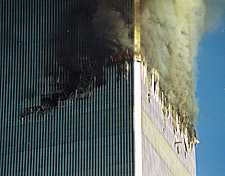September 11 was all about the power of images; the impact of the first plane into the North Tower guaranteed that the eyes of the world would be trained to witness the impact of the second plane in real time. But let's not forget that it's not just about visual spectacle: it's real people dying, it's real destruction.
There are some Christian images which have also influenced and confused the way the event has been talked about.
A good example is the steel cross found at the World Trade Centre site.
Consisting of two steel beams welded together, it survived the destruction of the towers and was uncovered upright in the rubble. Because it resembled the Christian icon it became somewhat of a rallying point for recovery workers in the midst of what was regarded as a 16-acre gravesite: they scored it with slogans and the names of their dead brothers. Perhaps inspired by this, smaller crosses were also carved out of steel from the fallen towers, to be given to museums and families, or kept as mementos for the recovery workers.
 But what is the cross? Before Christ, it was an emblem for the most heinous method of capital punishment. Now, 2000 years later, even in secular circles the cross is still a symbol of salvation, so it's not inconceivable that the World Trade Centre cross should become such a focal point for comfort, even divorced from its specifically Christian meaning. The cross, when paired with human death, operates in secular circles as a symbol of comfort for the living left behind. And it's this variant of meaning, not its Christian connotation of a reminder of God's sacrificial love for the world, which holds sway at the site, and I maintain this because while a lot of talk about the cross mentions "faith' it fails to specify what in, let alone mentioning the name Jesus Christ.
But what is the cross? Before Christ, it was an emblem for the most heinous method of capital punishment. Now, 2000 years later, even in secular circles the cross is still a symbol of salvation, so it's not inconceivable that the World Trade Centre cross should become such a focal point for comfort, even divorced from its specifically Christian meaning. The cross, when paired with human death, operates in secular circles as a symbol of comfort for the living left behind. And it's this variant of meaning, not its Christian connotation of a reminder of God's sacrificial love for the world, which holds sway at the site, and I maintain this because while a lot of talk about the cross mentions "faith' it fails to specify what in, let alone mentioning the name Jesus Christ.
There are problems with transplanting a Christian symbol onto the World Trade Centre site:
Firstly, it positions the West for a clash of civilisations confrontation for the 21st century: the Christian West versus the Islamic Mid-East. This isn't helped by President Bush's Freudian slip in characterising the campaign a "crusade' or initially naming the venture into Afghanistan "Operation Infinite Justice'. This mobilises discomfiting racial stereotypes of white men fighting against brown men and white men liberating brown women from brown men, and seeks to universalise a specific cultural mindset in the fight for "civilisation' against "pre-modern', "primitive' societies ruled by "tribal conflicts'. (The Lord of the Rings trilogy and Peter Jackson's follow-up King Kong play this racial conflict out onscreen.)
Secondly, in American culture, ground is made sacred when blood is spilt on it. The Christian cross, with its attendant emphasis on the redeeming blood of Christ, can confirm or be seen to sanction this sacralisation. It can also be seen to approve of the transformation of the people who died at the World Trade Centre from victims to heroes. Now obviously, the Christian narrative operates along these lines as well (Jesus the suffering servant transformed into the conquering king) but when the September 11 dead are addressed as soldiers who died for their nation you have to wonder at what kind of political end this is directed towards" perhaps an indefinite War on Terrorism? And the designation of something as "sacred' seems to insinuate that it is beyond debate; that to seek to interpret is the same as dishonouring the memory of those who died.
So when we are called to respond as Christians to these kinds of images, especially seemingly Christian ones, I would encourage you to subject them to scrutiny, because in secular culture they are almost always deployed with political intent which masks their Christian meaning, and in some ways misrepresents Christianity even more. But at the same time, respond to them as emblems of grief which strive to re-member the dead. Take comfort in the bodily renewal of Christ.
















